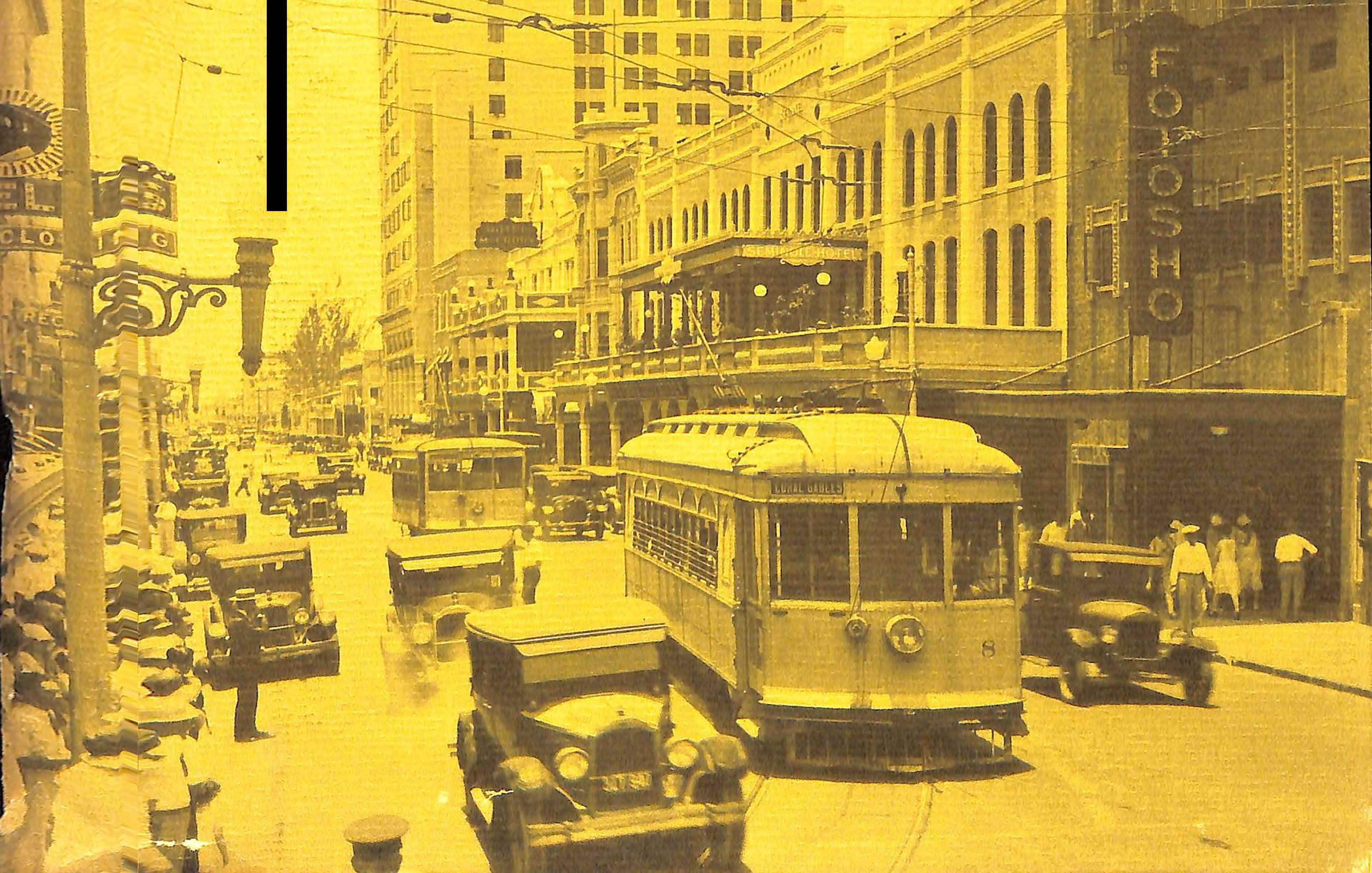Bl- CAY EBAY TROLLEYS
STREET RAILWAYS OF THE MIAMI AREA


 by Edward Ridolph
by Edward Ridolph






 by Edward Ridolph
by Edward Ridolph



Published and sold by: Harold E. Cox 80 Virginia Terrace Forty Fort, PA 18704
Copyright 1981 by Harold E. Cox



Front cover: Coral Gables Rapid Transit car 8 is sh own in June J 926 turning South from Flagler Street into S. E. 1st Avenue to beg 1 n 1- ts out�ound run to Coral Gables. Coral Gables Birney 107 follows, having come in Irom the Gables on the local 1 ine via Ponce de Leon and West Flag ler . Romer Col I. Miami-Dade Pllblic Library. d f o m do wntown Mi am.i at Back cover: Three Birneys pau s e on outboun trip s � . h R . J h l dis Miami Beac ai way S w ] st Street and S. W. 2nd Avenue. In t e ea . .11 h l G bl ·d T which w1 turn sout on car 361 a former Cora a es Rapi rans1 t ca r, . . . f ' · h h s 1· Behind it is City o: 2nd Avenue for its run out t e S. W. 6t treet ine. . Miami car 217 on the N. W. 3rd Avenue line. In the rear, an ot her City . oI Miami Birney is running on the N. W. 7th Avenue 1 ine. Ste phen n. Magul re.





city's transportation picture until the early 1920s.
The ordinance limited the line to a single track, and called for either electric power or some other source approved by the council. The partners 1 et the idea 1 ie dorman t for near ly a year. Then, as the city's te nth anniversary approached, they decided the time was right to bring modern transportation t o the expanding town.
Q, 18 April 1906, the Miami Street Railway C ompany proudly announced in the press that track laying was about to begin. No less than three carloads of rail had already arrived, and a gang of workmen had been sent into the p ine woods surrounding the city to cut trees for crossties. The comp any also announc ed that surp lus electric power from the trolley operation would be sold to furnish power for fans and the few other primitive ele ctric a ppliances that the company would make available.
By June track laying had progressed so well that manager J. H. Tatum confidently announced that service would begin in time for the city's tenth anniversary celebration on 25 J uly. S ev eral bl ocks of track ha d already been spiked down along 12th Street, the city 's main east-west thoroughfare . Track crews were poised to begin layin g rail north on Avenue D towa rd the Florida East Coast depot on 6th Street , which was to be th e t emporary termi nus. However , a sn ag developed in the form of some rathe r sti ff opposition from property owners along Avenue D, who didn't want their hard-packed street disturbed. In the free and easy style of the time, the company simply announced they would move one block east to Avenue C, and put the rails down there. Apparently Av enue C's reside nts weren't any more in favor of modern 6
.\ltami ElPctric car 1 posed on Avrnue B near the FE C Depot u1 1906. Brill 22 trucks. This car was second hand from the Metropo litan St. Ry. of New York. Steve '11a g-u ire.
transpo rtation at their front door than were their Ave nue D neighbors, because the track layers had to take an oth er ju mp east and start laying rail on Avenue B. TI1i s was the route fi na lly foJ]owcd.
Beg inni ng at the po wer h ous e an d what passed for a car barn just east o f the Miami River, the track reached norLh to 12th Street where it turned east,crossed the FEC, and ran several bl oc ks to Ave nue 13. There the line turned north to the FEC depot on 6th Street. Altho ugh the total rou te was mea su red in bl ock s rat he r than m jJe s, virtua l ly every important section of the city, from downtown to the depot, was reached.

Early in July, two half-op en, half-cl osed Metropo litan type cars were readied for service . These had be en acquired sec o nd-hand from the Metropolitan Stre et Railway of New York City and were we!! used bef ore appearing in Mi am i. Oddly enough , despi te Miami's mild climate, they were the only open cars to ever run in the city-
On 23 July 1906, with an electrician from the power hous e at the contr ols, one of Lhe cars made a tentative trip over the n ew line. Th e run was made onJ y to insur e t hat the 1 ine and equipme nt were ready for operati on, and no passengers werP. c:arrj ed. TI1P. ba lance of that day and all of the n ex t were u sed in getting the bugs out of the system in preparation for the beg inning of passenger service.
O n We cl n es day , 2 5 J u 1 y 1 9 O 6 , s eve r a 1 thousand people crowded in to down town Miami to help celebrate the city's te11 th birthday, and just as Tatum had predicted, the Miam i El ectrj c Raj 1 way Co. was ready for b usiness. Ear ly th at morning one car beg an rattli ng over an abbreviated route that began at the FEC depot on 6th Street and �nded at the FEC crossing on 12th Street, on the western

One of the two Brill Metropolitan cars shares Avenue B with two bicyclists and a lone horse drawn carriage in this 1907 picture. Ridolph Collection.
fringes of downtown Miami. The car shuttled back and forth over the line throughout the day, as hundreds of Miami residents took advantage of the new transit system. Although the line was relatively short, it did serve the com mercial areas of the city. And certainly a ride on the trolley was a great improvement over walking, riding a bicycle , or guiding a horse along roads that could be either very muddy or very dusty, depending on the season. The presence of an operating electric railway in a fast growing little city that only a decade earlier was hardly more than a trading post was a great source of pride to the city's residents.
111e new trolley line lost little t.ime in making its physical presence felt on Miami's stre ets. Although traffic was relativel y light in that era, and only a handful of automobiles roamed the streets, there were still enough vehicles to contest the right of way. On 3 August, just a week after beginning op eration, the first· coll ision occurred. A lumber wagon attempted to cut in front of a car on 12th St reet and was ra mmed and overturned by the troll ey. Proving the old adage that acci dents come in threes,less than

an hour later and a block away the car hit a mule_ c�rrying a passenger. As in the first collision, there were no injuries. The next day, however, on Avenue Bat 10th Street the tro11e� frightened a horse pulling a b�ggy. 111e a�imal bolted right into the path of the oncomi�g car, and this time the buggy rider was sl�ghtly injured. Apparently both human and animal residents of the city became more wary of street cars after this initial round of collisions because no further mention was made of any accidents.
Although accidents may have been unavoid able, the company did make some ef fort to carry on a good neighbor policy. Th e motormen and conductors were always most accomodating to p�ssengers, stopping anywhere on signal to pick up or discharge passengers. This courtesy also extended to other areas of the company'� operations. Wh en the screech of the car turning the corner at Avenue Band 12th Stre�t became too much for Miam i's first physician, Dr. James Jackson, who had his home and office on 12th Street, the company employed an elderly black man to perjodically grease the rails on the curve.
_ The street car line had been in operation J�st over two months when Manager Tatum, lnn ting at the availability of "N ew York cap1tal II a d , nnounce on 28 September that work 0� several extensions to various parts of the cit� would begin as soon as the necessary equipment arrived. Northern money must have

A Mia�i Electric Railway Co. car eastbound on 12th Street at Avenue C. The First National Bank is to the right. Note that the car tracks were of fset to the South side of the st reet. Ridolph Collection.

been slow in coming, because no major extensions were begun and a lone car continued to shuttle up and down the line. However, on 7 Dec emb er a more positiv e step in the direct ion of "w hat might have be en" took place when the railway company took tit le to a 1 arge tract of 1 and near Lemon City, a settlement on the FEC several miles north of Miami.

The promoters ' intentions were to build an interurban line between Miami and Lemon City, roughly p aralleling the FEC tracks , erect the usual traffic stimulating amusement park at the end of the line, and then place 900 of their building lots on the market. Unfortunately , this idea like similar ones that would characterize Florida's flamboyant land boom some two decade s late r die d abo rning. '
�he comp an y, und eter red by failu re, contin�ed to plan expansion. On 15 December operation began over what would be its only extension. Several blocks of track on 12th
from the FEC crossing w est to the Miami River was placed in service, and at the opposite end of the line the tra ck on 6th Street was extended two blocks to Avenue D. At the same ti me the company announced that two new car ld . s wou arrive shortly and they would be d • use on a contemp lated be lt line completely around the city. Only one of the 8
two new cars ever made its appearance, and it was new in name only. Ar riving in January 1907, it brough t the fleet to its all time high of three cars. The be lt line, needless to say, never made an appearance.
Meanwhile the track gar,g was staying busy, laying rail across the 12th Street bridge and due west through the fields to the vicinity of Avenue L, where the line tu rne d north to stil l another planned amusement pa rk,this one just south of the Miami River. Th is area, known as Riverside, had few streets ann only a col le ction of farmh ouses to fu rnis h potent ial patrons. Th e line co nsisted of rather haphazardly const ruc ted right of way th rough the fields, and the abse nce of any overhead wire indic ated the company's Jack of faith in the immediate future of the area. Although trolleys of the Mi ami Elect ric never reached an amusement p ark in Riverside, the extension became the sc ene of one of the traction industry's more exotic experiments.
In the middle of February 1907,an inventor known as Captain Beecher arrived in Miami and made arrang ements to test an unusual rai J vehicle over the idle Riverside tr acks. His creation, which resembled an oversize golf cart with two outward facing center benches and a flat roof, was powered by a sputtering gas engine and carried ten passeng ers. TI1e two things which set the car apart from i ts mo re pr osa i c breth ren were the u se of flangeless whee ls and a third center rail which the car gripped to stay on the tracks . According to the inventor, i t was vi rt ua.lJy impossible to derail the Jittle car, and it could take the sharpest curves at a high rate
of speed and stiJ J remain upright. Exactly how passengers would view a sudden jolting swing around a sharp curve w as never made c 1 ear.
The car ran through several weeks of tests without mishap, and at the end of February Beecher pronounced it a complete success. After announcing the us ual stock issue to finance his operation, and making plans to display the vehicle at the Jamestown Exhibition, Captain Beecher and his car vanished from the Miami traction scene.
A lthough Beec her and his car were gone, the Miami Electric Railway still had designs on Riverside. In April the com pany sent a crew to remove the center rail and to make some improvements to the unfinished amusement park at the end of the line. Early in May the company announced that service ove r the Riverside extension would begin about 16 May, and would coi ncide wi th the opening of the amusement park. The announcement was premature, because the line apparently never w ent into operation. Although the exact reasons are now 1 ost iu obscurity, educated speculation would suggest a combination of factors. First, other than livestock and wildlife , the area was lightly populated, and the amusement park was out in th e middle of no where. Even more important, the wooden 12th Street bridge over the Miami River,whiJe adequate for horse-drawn wagons, was too weak to su pport a he avy double-t ruck trolley loaded with passengers. This was men tioned several times when the company tried to have the bridge reinforced after tracks were laid. So, for the last few months of its existence, the company had to be content with running its trolleys from the depot to the river.
For several days in early August 1907, the street car line was the focus of some rather unpleasant racial incidents which fortunately ended before th ey escalated to the degree al] too common in that era. On the night of 1 Au gust, a westbound car on 12th Street carrying a numLer of black pas sengers came under an egg and rock barrage as it passed Avenue D. The causes were obscure, but one passenger suffered a severe eye injury, while others simply abandoned the car and fled down side streets. The pol ice chief prom ptly arrived on the scene and dispersed the crowd before th e event went any further. Twu nights later, a crowd of blacks renewed h ostilities with an eastbound car at Avenue C as their target. Again the results were non-lethal and the event quickly ended. Apparen tly both sides then decided that che score was best
left in a tie, as there were no further attacks on trolley passengers of either race.
St rict seg regation was the ac cepted practice on street car systems throughout the South, as well as in certain other parts of the count ry after the turn of the century. One curious practice on the Miami cars was the separat ion of the races according to weather conditions. In the summer months, blacks rode in the closed section of the car, w hile w hite passengers rode in the open section. In the winter, which could be brisk, blacks were given the luxury of a ride in the open, while white passengers took over the closed section.
On 3 September 1907, Superintendent Albert Ogle issued a rathe r terse announcement via the press that the Miami Electric Railway would end service that day, and wou ld not resume for three to fou r w eeks. This was not the first suspension. An accident at the power house had closed down the line from 30 January to 26 March, and when the cars began running again they used power from the ice pl ant. This time, however, the ice plant couldn't help out.

Officially, the company stated that the cars were in such poor condition after a year of daily servi ce that at least a month would be needed to overhaul them and put them back into cond i tion for the upc oming winter tourist sea son. No do ubt the equi pment, marginal at best when the company bought it and sufferin g from an additional year of wear and tear and minimal maintenance, was in bad shape. There is also little doubt that the operation was not the financial success its backers had expected it to be. Ogle was careful to announce that the company would continue to fu rnish electric power to its subscribers, and would soon have a new supply of appliances to sell. It was unfortunate for the people who had grown to depend on t h e trolley line for their daily transportation, but electric power was the only business the company found profitable.
The cars w ere stored at the po w er house for a short time, w hile some of the more easily removed rail was taken up and the overhead wire pulled down. Within a matter of months most of th e eq uipment had bee n dispos' ed of, leaving only a sh ort secLion of rail in a brick-paved section of 12th SLreeL as the last vestige of street car trnnsportation in Miam i . The first insLal l111enL in Miami's colorful sLreeL railway history had come to an abr11pL end, an d ncn r I y a decade would pass before street cars would again appPF1r in the city,
























































































